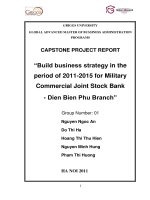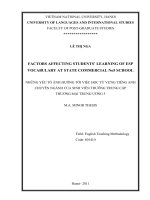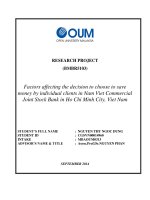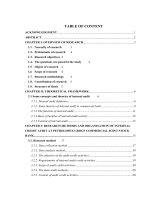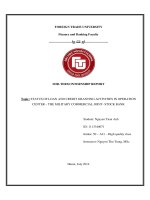Factors affecting customers’ acceptance of the adoption of blockchain technology at dong a commercial joint stock bank, Hue branch
Bạn đang xem bản rút gọn của tài liệu. Xem và tải ngay bản đầy đủ của tài liệu tại đây (945.32 KB, 12 trang )
Hue University Journal of Science: Economics and Development
pISSN 2588-1205; eISSN 2615-9716
Vol. 129, No. 5A, 2020, pp. 5–16; DOI: 10.26459/hueuni-jed.v129i5A.5728
FACTORS AFFECTING CUSTOMERS’ ACCEPTANCE OF THE
ADOPTION OF BLOCKCHAIN TECHNOLOGY AT DONG A
COMMERCIAL JOINT STOCK BANK, HUE BRANCH
Duong Dac Quang Hao1*, Tran Thai Hoa1, Nguyen Huu Dung2
1
University of Economics, Hue University, 99 Ho Dac Di St., Hue, Vietnam
2
Sichuan University, Shuncheng St., Qingyang, Chengdu, China
Abstract: This study aims to develop and test the integrative model of the factors affecting customers’
acceptance intention of the adoption of blockchain technology. Data were collected from a sample of 195
customers who have been conducting transactions at Dong A Bank – Hue branch. Samples are selected by
using the systematic random sampling method. Structural equation modelling (SEM) is used to test the
hypothesized relationships. The findings indicate that six out of eight tested relationships are supported.
Perceived usefulness (PU) and Perceived ease of use (PEU) are the most critical factors affecting customers’
Attitude (AT). Attitude also has a direct and positive correlation to customers’ acceptance Intention (IN).
Notably, Personal characteristics (PC) and Risk perception (RP) are the two most influential factors affecting
Perceived usefulness. And, the Perceived ease of use factor is only affected by customers’ Self-command
(SC). In general, this study contributes to enriching the existing knowledge of blockchain adoption in banks
and helps banks figure out an efficient way to adopt blockchain technology.
Keywords: customers’ acceptance, blockchain adoption, Dong A Bank, Hue branch
1
Introduction
Blockchain’s
key
properties
of
decentralization,
immutability,
efficiency,
cost-
effectiveness, and security are leading to growing support for the technology’s adoption across
the entire range of the banking system [13]. According to PricewaterhouseCoopers (PwC), 77
percent of financial institutions are expected to adopt blockchain technology as part of an inproduction system or process by 2020 [15]. Regardless of the enormous benefits of blockchain,
the adoption of this technology in banks is doubted by their customers. Lack of technology
proficiency, status quo mindset, the credibility of blockchain, and regulatory complexity are
common constraints for customers’ acceptance [20].
In recent years, along with the increasing concerns of banks about blockchain, the topic of
assessing factors affecting customers’ acceptance of the adoption of blockchain technology has
thus been recognized as a field of growing interest worldwide [22]. Much research has been
implemented to build an efficient solution to integrate blockchain into the existing banking
* Corresponding:
Submitted: March 20, 2020; Revised: April 6, 2020; Accepted: June 9, 2020
Duong Dac Quang Hao et al.
Vol. 129, No. 5A, 2020
system in a user-friendly way [3, 13]. Some authors interest in clarifying the benefits and
drawbacks to customers when blockchain is applied in banking transactions [12, 19]. Another
group of researchers try to analyse the belief, attitude, intention, and behaviours of stakeholders
in the supply chain of financial services on blockchain solutions [16, 18]. Despite the increase in
the number of related works, there are still gaps in the knowledge base. Although some authors
notice on the factors affecting customers’ acceptance intention, these studies still have not reached
a consensus on the quantitative model and scales to measure these factors [11]. Especially, in the
case of blockchain, the new technology would create new unknown factors. Besides, blockchain
issues in general and blockchain applications in banks are still a new topic in Vietnam. The
researchers have not yet thoroughly tested the blockchain acceptance models in the practice of a
bank or financial institution in general [11].
From a practical perspective, Dong A Bank, with the strategy of becoming a leading bank
for applying new financial technology, is considering to deploy blockchain applications in the
next 3 years.
From the above urgent problems with the case of Dong A Bank – Hue branch, this study
was carried out with two main objectives:
– Identify and analyse the factors affecting customers’ acceptance of the adoption of
blockchain technology.
– Propose policy implications to help the bank figure out an efficient way to adopt
blockchain technology.
2
Literature review
Blockchain is defined as a growing list of records, called blocks, that are linked by using
cryptography. Each block contains a cryptographic hash of the previous block, a timestamp, and
transaction data [13]. For use as a distributed ledger, a blockchain is typically managed by a peerto-peer network collectively adhering to a protocol for inter-node communication and validating
new blocks. Once recorded, the data in any given block cannot be altered retroactively without
the alteration of all subsequent blocks, which requires consensus of the network majority [23].
There are six most potential applications of blockchain in banks, including 1) Fraud
Reduction – Most banking systems in the world, built on a centralized database, are more
vulnerable to cyberattacks because once hackers attack one system, they get full access to it.
Blockchain would eradicate some of the current crimes committed online today against our
financial institutions [22]; 2) Payments – Blockchain would eradicate all the intermediaries in the
payment processing system to build higher security with minimal costs to process payment [16];
3) Smart Contracts – Blockchains facilitate smart contracts as computer code that can be executed
6
Jos.hueuni.edu.vn
Vol. 129, No. 5A, 2020
once two or more parties enter their keys. Contracts could be created, and financial transactions
could be executed when this code is programmed according to the set criteria [12]; 4) Know your
Customer (KYC) – Blockchains allow an organization to access the verification details of a client
by another organization, thus avoiding repetition of the KYC process. The reduction in
administrative costs for compliance departments would be significant [8];
5)
Clearing and Settlement – Banks could transfer post-trade clearing and settlement on to a
blockchain system [17]; 6) Trade Finance – Blockchains could digitize the entire trade ecosystems.
For instance, bills of lading or letters of credit are mostly based on paper and contain very
important information of the supply chain that numerous parties need access [12].
Although blockchains bring numerous benefits to the banking system, there still exist
constraints preventing the adoption of this technology in both macro aspects (such as requiring large
investments in infrastructure, a need of a solid legal foundation, etc.) and micro aspects (such as the
acceptance of stakeholders in the supply chain of banking services, their knowledge and ability to use
new technology, etc.). Among them, customers’ acceptance is the most important one [17]. Various
characteristics have been identified, which appear to influence customers’ acceptance of new
technology, like blockchains. Among them are:
Relative advantage. This is the degree to which potential customers perceive the innovation
as superior to existing substitutes. Some of the factors involved could include economic
profitability, low initial costs, lower perceived risk, decrease in discomfort, savings in time and
effort, and immediacy of reward factors. Relative advantage is positively related to the diffusion
rate [6].
Compatibility. This is the degree to which potential consumers feel that innovation is
consistent with their socio-cultural norms or is consistent with existing values, experiences, and
needs. Previously introduced ideas will impact the adoption of any new technology. The rate of
adoption is affected by the old idea it supersedes – the more compatible it is with the previous
idea, the less of a change it is. Compatibility is positively related to the diffusion rate [15].
Complexity. The innovation is perceived as difficult to comprehend or use. Complexity is
also related to the number of decisions required as well as the number of decisions that must be
repeated. Complexity is highly negatively correlated with the rate of diffusion [8].
Trialability (divisibility). This is the degree to which a new product is capable of being tried
or experimented on a limited basis by consumers. Trialability is a positively related trait to the
diffusion rate.
Observability. This is the ease with which a product’s benefits or attributes can be observed,
imagined, or described to others. This is also positively related to the diffusion rate [7].
7
Duong Dac Quang Hao et al.
Vol. 129, No. 5A, 2020
Regarding the research model related to customers’ acceptance of technology adoption,
there are three most popular models, namely Theory of Reasoned Action (TRA) [2], Theory of
Planned Behaviour (TPB) [1], The Technology Acceptance Model (TAM) [6]. Ajzen and Fishbein
[2] propose TRA, which aims to explain the relationship between attitudes and behaviours within
human action. It is mainly used to predict how individuals behave from their pre-existing
attitudes and behavioural intentions. There are seven factors in this framework: behavioural
beliefs, outcomes evaluation, attitude toward behaviour, normative beliefs, motivation to
comply, subjective norms, and behavioural intention. In the theory of planned behaviour, Ajzen
[1] states that intention toward attitude, subjective norms, and perceived behavioural control,
together shape an individual's behavioural intentions and behaviours.
The technology acceptance model is an information systems theory that models how users
come to accept and use technology. In this framework, Davis and Bagozzi [6] suggest two primary
factors influencing an individual's intention to use new technology: perceived ease of use and
perceived usefulness. These factors are affected by external variables, such as social influence.
When this matter (TAM) is in place, people could have the attitude and intention to use the
technology. However, the perception may change depending on age and gender because
everyone is different. Lastly, Unified Theory of Acceptance and Use of Technology (UTAUT) is a
technology acceptance model formulated by Venkatesh and others [24]. The UTAUT aims to
explain users’ intentions to use an information system and subsequent usage behaviour. The
theory holds that there are four key constructs: 1) performance expectancy, 2) effort expectancy,
3) social influence, and 4) facilitating conditions.
From the above-discussed theories and models and the qualitative research step, the proposed
research model is drawn according to the Technology Acceptance Model with the correlation among
Figure 1. Proposed research model
8
Jos.hueuni.edu.vn
Vol. 129, No. 5A, 2020
personal characteristics, risk perception to perceived usefulness; the correlation among trust, selfcommand to perceived Ease of Use; and the relationship between social influence and customers’
acceptance intention (Figure 1).
3
Methods
Data collection
In this study, the authors used both qualitative and quantitative data. The secondary data were
collected from the department of electronic banking and the department of loan servicing at Dong
A Bank – Hue branch. These data sources provide an overview of the current state of technology
application, credit risks, and loan activities.
The qualitative research step then is implemented to discuss the adjusted measurement
scales, proposed hypotheses, and integrated model. In this step, in-depth interview and group
discussion methods were used to explore the view of eight experts (including two senior
researchers who are knowledgeable about the research topic, and six experienced bankers
working in different departments of Dong A Bank – Hue branch). The average time for an
interview was about 60 minutes. The results of this step helped to eliminate the unsuitable
variables in the proposed framework (such as confidential information about customer's banking
transactions and their behaviors) and built the quantitative questionnaire.
For the quantitative research step, all the variables in the structured questionnaires were
measured through the five-point Likert scale. The ratings start from 1 (strongly disagree) to 5
(strongly agree). Samples include customers who have been conducting transactions in the bank.
The samples were selected by using the systematic random sampling method. The interviewer
questioned the customers in turn out of the bank with a jump of k = 3.
The sample size was judged regarding the population means. In total, 206 respondents
were interviewed, of which 11 questionnaires were unusable because of inappropriate responses
and missing data. Finally, 195 questionnaires were suitable for analysis.
Sample description
The respondents consist of 58.5% men, aged 20 to over 45, with an income from 3 to over 20
million VND per month (Table 1). Regarding their perception about risks in banking transactions,
most of the surveyed customers concern about the risk of time-wasting (77.2%); too many steps and
9
Duong Dac Quang Hao et al.
Vol. 129, No. 5A, 2020
Table 1. Demographic profile
Category
Gender
Age
Income
Risks in
customers’
transactions
Frequency (n = 195)
Percentage (%)
Male
114
58.5
Female
81
41.5
Under 20 years old
27
13.8
20 – 45 years old
66
33.8
Over 45 years old
102
52.3
Under 3 million VND per month
14
7.2
3 to 10 million VND per month
107
54.9
10 to 20 million VND per month
47
24.1
Over 20 million VND per month
27
13.8
1. The risk of time-wasting
104
53.1
151
77.2
168
86.2
159
81.5
176
90.1
60
30.9
2. Too many steps and documents
to do transactions
3. The risk of losing money by
fraud and cyberattacks
4. High cost for banking cards,
transaction fees, etc.
5. Money transfers take long time
and high costs
6. Banking transactions cannot be
processed during non-business
hours
documents needed to do a transaction (86.2%); high cost for banking cards, transaction fees, etc.
(81.5%); and banking transactions cannot be processed during non-business hours (90.1%).
4
Findings
4.1
Factor analyses
Exploratory factor analysis
The exploratory factor analysis (EFA) was conducted to determine the number of extracted
factors on each scale. In this study, the principal components factor analysis and the Promax
rotation method were applied. The results show that the measurement scale is satisfied all
requirements: Kaiser–Meyer–Olkin coefficient > 0.5; the significance level of Bartlett's Test of
10
Jos.hueuni.edu.vn
Vol. 129, No. 5A, 2020
Table 2. EFA and CFA of the measurement models
Exploratory Factor Analysis
Confirmatory Factor Analysis
KMO
Sig. Bartlett's
test
Total variance
extracted
CMIN/
DF
GFI
TLI
CFI
RMSEA
0.822
0.000
76.668%
1.612
0.900
0.916
0.926
0.056
Sphericity < 0.05; Eigenvalue of each extracted factor > 1; total variance extracted > 50%,
and factor loading of each item > 0.5 [4, 9] (Table 2). Nine representative factors are extracted from
36 observed variables in the proposed scale, including Personal characteristics (PC), Risk
perception (RP), Perceived usefulness (PU), Trust (TR), Self-command (SC), Perceived ease of use
(PEU), Attitude (AT), Social influence (SI), and Intention (IN).
Confirmatory factor analysis
The confirmatory factor analysis (CFA) was conducted to test the scale reliability, convergent,
and discriminant validity of the constructs. The confirmatory factor analysis allows for a more
objective interpretation of validity and establish items reliability and construct’s accuracy [10].
Model fit
The key indicators in the measurement model provide good fit to the data: χ2/df < 3, Comparative
Fit Index (CFI) > 0.9, Goodness-of-fit index (GFI) > 0.9, Tucker & Lewis index (TLI) > 0.9, and Root
Mean Square Error Approximation < 0.08), [10] (Table 2). These hypothesized models then were
compared with possible alternative models. The results indicate that the hypothesized
measurement models outperformed the alternative ones.
Reliability analysis
The indexes in Table 3 indicate that the reliability values of the measurement scale are higher
than the recommended values: the Cronbach’s alfa coefficients (Alfa) > 0.7, Composite Reliability
(CR) > 0.7, and average variance extracted (AVE) > 0.5 [9]. These results mean that the research
scale is reliable.
11
Duong Dac Quang Hao et al.
Vol. 129, No. 5A, 2020
Table 3. Scale reliability analysis
Scale Reliability
Scale
Alfa
CR
AVE
Personal characteristics (PC)
0,931
0,914
0,679
Risk perception (RP)
0,881
0,882
0,652
Perceived usefulness (PU)
0,897
0,897
0,685
Perceived ease of use (PEU)
0,895
0,895
0,681
Trust (TR)
0,887
0,887
0,662
Self-command (SC)
0,876
0,878
0,643
Attitude (AT)
0,884
0,885
0,258
Intention (IN)
0,884
0,887
0,668
Social influence (SI)
0,878
0,906
0,723
Construct validity
The construct validity is evaluated through the convergent and discriminant. The scale achieves
convergent validity if it satisfies two requirements: the standardized weights in the measurement
model are higher than 0.5, significant with p-value < 0.05, and the average variance extracted
(AVE) > 0.5 [10]. From the analysis results, the standardized weights range from 0.695 to 0.957,
with all of the p-values less than 0.05. Besides, all of the AVE values are higher than 0.5 (Table 4).
Therefore, the measurement model in this study achieves convergent validity.
The discriminant validity assures that a variable is unique and captures the phenomena
not represented by other varying constructs in the model. The Fornell–Larcker criterion is the
Table 4. Analysis of discriminant validity
PC
PC
RP
PU
RP
0.824**
0,240
0.807
PU
0,155
0,208
0.828
SC
TR
PEU
AT
SI
SC
0,139
0,33
0,341
0.814
TR
0,138
0,127
0,147
0,071
0.802
PEU
0,543
0,286
0,076
0,032
0,154
0.825
AT
0,318
0,483
0,214
0,332
0,271
0,315
0.508
SI
0,088
0,034
0,070
0,030
0,425
0,207
0,159
0.817
IN
0,353
0,384
0,422
0,325
0,317
0,313
0,463
0,173
IN
0.850
Note: ** – Square root AVE of each variable – sqrt(AVE)
12
Jos.hueuni.edu.vn
Vol. 129, No. 5A, 2020
e1
Personal
H1
Characteristi
cs
Risk
Perceived
.213
Usefulness
.189
H2
Perception
H5
e3
e4
.226
Attitude
e2
H7
Intention
.465
.311
Perceived
Selfcommand
H6
Ease of Use
.167
H4
Figure 2. The results of SEM analysis
most popular method used in assessing discriminant validity. This standard requires the square
root of AVE of each variable to be higher than the correlations among variables in the
measurement model. The results in Table 4 show that the research model meets the these
requirements.verall, the three tests mentioned above suggest that the measurement model is fit,
reliable, and constructs validity.
4.2
Hypotheses testing
Structural equation modelling was used to test the developed hypotheses. From the analysis
results, among eight tested relationships, six are supported with the p-value ranging from 0.00 to
0.05. Namely, Personal characteristics and Risk perception positively affect Perceived usefulness,
with the standardized regression weights of 0.213 and 0.189, respectively. The Perceived ease of
use factor is only affected by Self-command with the parameter estimate of 0.167. Meanwhile, the
relationship between Perceived ease of use and Trust is not significant with the p-value of 0.697.
Notably, Perceived usefulness and Perceived ease of use positively and strongly affect
Attitude of customers about accepting the adoption of blockchain technology at Dong A Bank –
Hue branch. Their standardized regression weights are 0.226 and 0.311, respectively. Similarly,
Attitude also strongly affects the acceptance Intention of customers, with the parameter estimate of
0.465. Conversely, the Social influence factor does not show a clear and strong correlation with the
acceptance Intention with the p-value of 0.126.
13
Duong Dac Quang Hao et al.
4
Vol. 129, No. 5A, 2020
Discussion and conclusion
Blockchain abilities allow banks to significantly transform their businesses to a new level, reducing
excessive bureaucracy, conducting faster transactions at lower costs, and improving its secrecy.
However, to bring this technology into reality, banks need the acceptance of customers. Identifying
factors affecting customers’ approval, thus becomes the top concern of bank leaders and scholars
around the world. In this study, the authors develop and test the integrative model of factors
affecting the attitude and acceptance intention of customers at Dong A Bank – Hue branch.
Regarding the measurement scales, the study finds that besides two primary factors
influencing an individual's attitude and intention to use new technology: Perceived ease of use
and Perceived usefulness. Personal characteristics, Risk perception, Trust, and Self-command are
also important indirect factors to build customers’ belief and their acceptance of blockchain
adoption. This finding helps to improve the original model of Davis and Bagozzi (1992).
Referring to risks perceived by customers in their banking transaction, the risk of losing
money by fraud, cyberattacks, high cost for banking cards, transaction fees, etc. are major
perceived risks. This emphasizes the potential application of blockchain in Dong A Bank – Hue
branch. These results are quite similar to those of customers in other countries, such as the US
[16] and China [23].
Finally, from applying structural equation modelling, six out of eight tested relationships
are supported. Perceived usefulness and Perceived ease of use are the most critical factors
affecting customers’ Attitude. This is supported by many studies. Similarly, Attitude also has a
direct and strong correlation to customers’ acceptance Intention. Besides, because Risk perception
and Personal characteristics reflect the extent of customers’ willingness to learn new technology,
these factors have a positive and direct relationship to customers’ Perceived usefulness. Similarly,
with high Self-command ability, customers could learn new technology easily and have Perceive
ease of using blockchain applications.
From the analysis results and group discussion among bank managers and blockchain
experts, the study offers six groups of solutions to enhance the applicability of blockchain
technology at Dong A Bank – Hue branch. Specifically, the bank should add all parties involved
in banking transactions into blockchain systems, and fostering an uncommon coordination
among banks to help transform payments at scale and help reduce the risk of failure. Further, the
bank needs to release a trial version of the blockchain applications for customers to experience,
evaluate, and perfect the application. The additional information about blockchain’s enormous
potential benefits and positive impacts is also needed to be provided adequately to customers
(through marketing campaigns, advertising pieces, and guidelines) to reduce the risk concerns or
uncertainty of service users.
14
Jos.hueuni.edu.vn
Vol. 129, No. 5A, 2020
Furthermore, a control system (including the necessary defined rights, obligations,
controls, and standards) and a customer assistant system are also necessary for improving
customers’ Perceived ease of use. Finally, the bank needs to build back-up plans for the situation
when the blockchain system is disrupted or does not achieve the expected outcomes.
In conclusion, from blockchain application theories and customers’ acceptance models, this
study helps Dong A Bank – Hue branch identify and analyse factors affecting customers’
acceptance intention on the adoption of blockchain technology. Regarding the limitation of this
study, the collected data have certain shortcomings. This is rooted in the relative evaluation
criteria and subjective opinions of interviewees. Therefore, in the future, there should be further
research with a broader research scope, data collected in research in the whole banking system.
Moreover, there should be new studies focusing on clarifying the features of the blockchain
applications to overcome all struggles identified in this study.
References
1.
Ajzen, I. (1991), The theory of planned behaviour, Organizational behaviour and human decision
processes, 50(2), 179–211.
2.
Fishbein, M., & Ajzen, I. (1975), Belief, attitude and behavior: An introduction to theory and
research. Massachusetts, USA.
3.
Ahram, T., Sargolzaei, A., Sargolzaei, S., Daniels, J. & Amaba, B. (2017, June), Blockchain
technology innovations, In 2017 IEEE Technology & Engineering Management Conference
(TEMSCON) (137–141), IEEE.
4.
Anderson, J. C. and Gerbing, D. W. (1988), Structural equation modelling in practice: A
review and recommended two-step approach, Psychological Bulletin, 103(3), 411.
5.
Arbuckle, J. L. (2006), 17.0 user’s guide. In Crawfordville, FL. Amos Development Corporation.
6.
Bagozzi, R. P., Davis, F. D. & Warshaw, P. R. (1992), Development and test of a theory of
technological learning and usage, Human Relations, 45(7), 659–686.
7.
G. Moore and I. Benbasat, Development of an Instrument to Measure the Perceptions of Adopting
an Information Technology Innovation (1991), Information Systems Research, 2, 3, 192–222.
8.
Grover, P., Kar, A. K., Janssen, M. & Ilavarasan, P. V. (2019), Perceived usefulness, ease of use
and user acceptance of blockchain technology for digital transactions–insights from usergenerated content on Twitter, Enterprise Information Systems, 13(6), 771–800.
9.
Hair, J. F., Black, W. C., Babin, B. J., Anderson, R. E., & Tatham, R. L. (2009), Análise
multivariada de dados, Bookman editora.
10. Hair, J. F., Black, W. C., Babin, B. J., Anderson, R. E., & Tatham, R. L. (1998), Multivariate data
analysis, 5(3), 207–219, Upper Saddle River, NJ: Prentice hall.
15
Duong Dac Quang Hao et al.
Vol. 129, No. 5A, 2020
11. Johansen, S. K. (2018), A comprehensive literature review on the Blockchain as a technological enabler
for innovation, Dept. of Information Systems, Mannheim University, Germany, 1–29.
12. Lindman, J., Tuunainen, V. K. & Rossi, M. (2017), Opportunities and Risks of Blockchain
Technologies–a research agenda, the 50th Hawaii International Conference on System Sciences,
USA.
13. Shah, T., & Jani, S. (2018), Applications of blockchain technology in banking & finance, Parul
CUniversity, Vadodara, India.
14. Lomax, Richard G., and Randall E. Schumacker (2004), A beginner's guide to structural equation
modelling, psychology press, United Kingdom.
15. Lundqvist, T., de Blanche, A. & Andersson, H. R. H. (2017, June), Thing-to-thing electricity
micropayments using blockchain technology, In 2017 Global Internet of Things Summit (GIoTS)
(1–6), Switzerland, IEEE.
16. MacDonald, T. J., Allen, D. W. & Potts, J. (2016), Blockchains and the boundaries of selforganized economies: Predictions for the future of banking, In Banking beyond banks and
money (279–296), Springer, Cham.
17. Pavlou, P. A. (2003), Consumer acceptance of electronic commerce: Integrating trust and risk with
the technology acceptance model. International journal of electronic commerce, 7(3), 101–134.
18. Shah, T., & Jani, S. (2018), Applications of blockchain technology in banking & finance, Parul
CUniversity, Vadodara, India.
19. Staples, M., Chen, S., Falamaki, S., Ponomarev, A., Rimba, P., Tran, A. B., ... & Zhu, J. (2017), Risks
and opportunities for systems using blockchain and smart contracts, Data61, CSIRO), Sydney.
20. Suh, B. & Han, I. (2003), The impact of customer trust and perception of security control on the
acceptance of electronic commerce, International Journal of electronic commerce, 7(3), 135–161.
21. Weber, I., Xu, X., Riveret, R., Governatori, G., Ponomarev, A. & Mendling, J. (2016, September),
Untrusted business process monitoring and execution using blockchain, In International Conference
on Business Process Management (329–347), Springer, Cham, Austria.
22. Yli-Huumo, J., Ko, D., Choi, S., Park, S. & Smolander, K. (2016), Where is current research on
blockchain technology?—a systematic review, PloS one, 11(10), e0163477.
23. Zheng, Z., Xie, S., Dai, H., Chen, X. & Wang, H. (2017, June), An overview of blockchain
technology: Architecture, consensus, and future trends, In 2017 IEEE international congress on big
data (BigData Congress), 557–564, USA, IEEE.
24. Venkatesh, V., Thong, J. Y. & Xu, X. (2012), Consumer acceptance and use of information technology:
extending the unified theory of acceptance and use of technology, MIS quarterly, 157–178.
16
